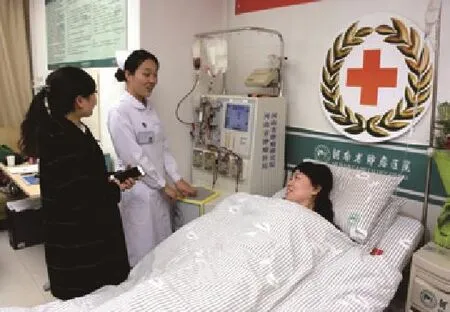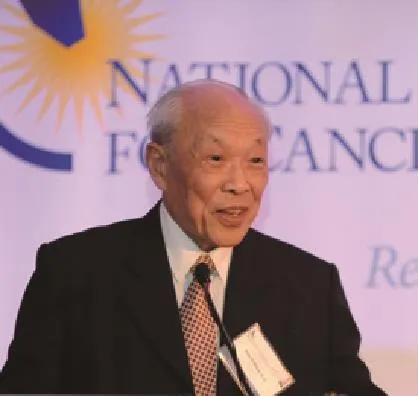Fighting Leukemia
2016-09-14ChinesephysiciansfindnewmethodstotreatthediseaseByTangYuankai
Chinese physicians find new methods to treat the disease By Tang Yuankai
Fighting Leukemia
Chinese physicians find new methods to treat the disease By Tang Yuankai
After more than three hours of collection,299 ml of hematopoietic stem cell suspension was extracted from the body of Ji Guochen,a postman in Suzhou,capital city of east China's Jiangsu Province,on June 10.The 26-year-old man thus became the province's first hematopoietic stem cell donor to Canada and the 28th donor to foreign countries.
In the 1980s,just before Ji's birth,a Japanese TV series named Akai Giwaku (1975)swept the Chinese mainland,depicting the consequences of a deadly disease to Chinese audiences.Fans were devastated when the series' heroine was struck by leukemia.
Just as the TV series was being aired in China,Chinese doctors managed to find a cure for the illness in 1985.
Wang Zhenyi,a Shanghai doctor who later claimed a number of international accolades in medicine,bar the Nobel Prize,successfully cured a patient of acute promyelocytic leukemia (APL).
Chinese research on leukemia began relatively late,but concerted efforts by generations of medical practitioners and scientists helped the country to catch up and even surpass other nations in some areas of leukemia treatment.Some Chinese medicines and therapeutic methods have garnered international attention and given hope to leukemia patients around the world.
Though leukemia still has a higher death rate than any other illness among men under 40 and women under 20,Huang Xiajun,a doctor from Beijing,has emphasized at many international academic gatherings that it's time to change the outdated concept that “leukemia is incurable.”
Beijing Protocol
Currently,the most effective way to cure leukemia is through hematopoietic stem cell transplantation,usually performed as a bone marrow transplant (BMT).
The method was discovered by U.S.doctor Edward Donnall Thomas (1920-2012) in 1978 and has been used frequently around the world since the 1980s.The finding helped Thomas win the Nobel Prize for Medicine in 1990.
Before a BMT,high-dosage chemotherapy is used to destroy a patient's hematopoietic system,then the donor's healthy marrow is transplanted to the patient's body to rebuild the immune system.
In this procedure,the donor and receiver must have matching human leukocyte antigens (HLAs),or the patient's body will reject the transplant,causing graft-versushost disease (GVHD).Caused by multisystem damage after a BMT,this type of disease often results in death.
Besides GVHD,other problems that may occur include healthy bone marrow being rejected for being considered “alien” and new bone marrow attacking the receiver's organs,such as the brain and the liver.
Xu Lanping,a senior doctor with the Institute of Hematology of Peking University,said that HLA is a series of genomes closely related to the human immune system and is regarded as the “identity card” of a human body.
HLA consists of two gene clusters,with half being from the father and half from the mother.Hence,a half-accordance rate exists between parents and children.Considering genetic probability,the 100-percent total-accordance rate of HLA is only found between monozygotic twins,while the total-accordance rate between siblings is 25 percent.The probability of the HLA total-accordance rate in the bone marrow bank is merely 11 percent,according to statistics from China Marrow Donor Program.
Huang Xiaojun,Director of the Hematology Department of Peking University People's Hospital,said that more than 80 percent of leukemia patients in China cannot find a suitable donor for bone marrow stem cells.
According to the China Marrow Donor Program website,by September 30,2015,a total of 2.06 million people had registered their marrow information in the program,but only 5,203 out of 48,732 patients who applied for an information inquiry had receivedbone marrow.

A woman in Henan Province donates her hematopoietic stem cells to a leukemia patient on November 16,2015
Last year,Huang and his group carried out BMT operations on almost 600 leukemia patients in 10 months.Critically,they enlarged the scope of donors to people with less-than-50-percent accordance,allowing the patients to choose other relatives such as cousins to be donors.This method is known as the haploid transplant.
In the late 1980s,some U.S.physicians attempted the haploid transplant,but less than 20 percent of the patients survived.Since then,U.S.physicians have considered this transplant as “mission impossible.”
There is a cell,known as the T-cell,in the bone marrow stem cells which often destroys both sick and healthy cells indiscriminately,causing GVHD.The T-cell is central to the haploid transplant dilemma.
According to a Xinhua News Agency report,in 1999,Italian physicians tried to remove the T-cell from a donor's bone marrow to avoid GVHD.However,without the T-cell,the new bone marrow's function was also weakened.It could not effectively kill unwanted cells in the receiver,thus it could not help recreate a new immune system.
Huang was more optimistic than his Italian counterparts.He believed the T-cell had a unique quality in marrow transplants that could be harnessed.“The T-cell is so strong that if we can find a way to control it,we can effectively use it in countering those malignant tumors,” Huang reasoned.
During his research,Huang found two types of medicine that can mediate and restrain the T-cell's function.His discovery formed the basic foundation of the so-called Beijing Protocol.
Today,China has more than 4 million leukemia patients and about 5,000 BMT operations are performed annually,with about half using the haploid transplant.In the past 10 years,approximately 20,000 leukemia patients have been able to lead a new life owing to the haploid transplant.This is a critical step in solving the worldwide problem of scarce source donors.
The Institute of Hematology of Peking University has become the largest center for allogeneic BMTs,and the haploid transplant method is considered a significant breakthrough in treating leukemia by international medical circles.In October last year,Biology of Blood Marrow Transplantation,an authoritative journal in the BMT field,published an article naming the finding the Beijing Protocol.
More than 50 hospitals in China and hospitals in tens of other countries,including Italy,Israel and South Korea,have adopted the method.Huang said the survival rate for the haploid transplant is about 70 percent,roughly the same as that for total-accordance BMT.

Wang Zhenyi,founder of the Department of Hematology of Ruijin Hospital in Shanghai,gives a speech at the Szent-Gyorgyi Prize award ceremony in New York City in 2012
The encouraging signs from Beijing have prompted physicians at Harvard University in the United States to begin experiments with the T-cell model.“Although we have different working mechanisms,physicians in China and other countries have testified the same thing: we can do BMT operations with less-than-half HLA accordance,” Huang told Xinhua News Agency.
Shanghai Protocol
Of all types of leukemia,APL is one of the most dangerous.Though it has a fairly low morbidity compared to other types of blood cancer,the mortality rate is very high.According to doctors,it can induce death within one or two days.
APL is caused by an arrest of leukocyte differentiation at the promyelocyte stage.The well-known Shanghai Protocol,originating from Shanghai Ruijin Hospital,is designed to counter APL.With the protocol,the remission rate for APL patients can reach over 90 percent.
Back in 1978,Wang Zhenyi,founder of the Department of Hematology at Ruijin Hospital,started to research a cure for APL.In 1985,Wang encountered a 5-yearold girl riddled with APL and on the verge of death.After a hard night,Wang made a bold decision: he let the girl drink all-trans retinoic acid,a kind of medicine for treating skin diseases.Three days later,a miracle happened—the girl's condition stabilized.After a week,the girl opened her eyes,and after one month,she was well on the way to recovery.
Beforehand,Wang's team had carried out a lot of experiments.Under the microscope,they found that many acute promyelocytic cells transformed into normal cells from the impact of all-trans retinoic acid.
In the past,chemotherapy was the most common way to treat leukemia.However,chemotherapy often kills healthy cells as well as bad ones,which always damages a patient's immune system.The situation caused much skepticism in Wang's mind over this method,encouraging him to seek a totally different solution for treating leukemia.
Having proposed his idea for a new method based on differentiation induction in the late 1970s,the Shanghai Protocol began to take shape in 1991 after the Ruijin Hospital found the core pathogenesis (the biological mechanism causing the disease) behind APL.
A significant breakthrough in 2000—combining all-trans retinoic acid and arsenic trioxide to treat APL—led to the possibility of curing adult leukemia.
In February 2012,the U.S.National Foundation for Cancer Research awarded Wang and Chen Zhu,a student of Wang who proposed the initial idea,the Seventh annual Szent-Gyorgyi Prize for Progress in Cancer Research for their innovative findings.This led to the successful development of the new therapeutic approach to APL,which can help to save millions of lives worldwide.■
Copyedited by Dominic James Madar
Comments to tangyuankai@bjreview.com
